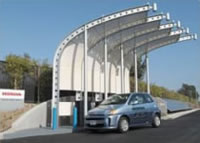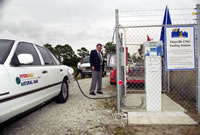
![]()
Utilization is the area of most interest to the public. All of the major automobile companies now have either a fuel cell or internal combustion engine powered by hydrogen. Hydrogen can be used as the fuel for both internal combustion engines and fuel cells.
When hydrogen is used in an internal combustion engine, some modifications to the engine must be made. See the Internal Combustion Engines page for details.
 |
| Solar-powered water electrolysis hydrogen fuel station at Honda R&D Americas, Inc., Torrance, CA (Photo: Honda R&D Co., Ltd) |
|---|
When hydrogen is used in a fuel cell, the automotive power train must be converted to electricity. A fuel cell converts the energy in the fuel, hydrogen and oxygen from air, into direct current electricity by electrochemical reactions. Fuel cells do not produce mechanical power. In reality, the fuel cell replaces the batteries in an electric vehicle. See the Fuel Cells page for details.
One issue involving the use of hydrogen for transportation is whether future vehicular propulsion will be based on fuel cell/electric motor or internal combustion engine (ICE) technology.
There are two major advantages of a fuel cell versus an internal combustion engine. The first is that the fuel cell is approximately twice as fuel-efficient as ICEs. In comparing efficiencies, the fuel cell and electric motor efficiency is about 45 percent efficient as compared to about 20 percent for the internal combustion engine.
The second advantage is the next generation of automobiles may very possibly be electric powered. The future car called the General Motors Autonomy is an example of an evolutionary and revolutionary vehicle design that uses an all-electric vehicle power train concept – fuel cell, electric motor, brakes, steering, other systems all controlled electronically. See http://www.autointell.com/nao_companies/general_ motors/gm-autonomy/gm-autonomy-02.htm for details. In the past, automobile electrification has not been achieved because battery technology cannot meet the weight, volume and range required for today’s automobile. Storing electricity for automotive use can only be done by use of fuel cells.
 |
| Hydrogen/CNG fueling station, Titusville, FL, Addison Bain (Photo: S. Spencer) |
|---|
However, the advantage of the internal combustion engine is its lower cost. Fuel cells cost $3,000 to $5,000 per kW, compared to $50 per kW for an internal combustion engine - a nearly 100-fold price differential. Thus, reducing cost is the major fuel cell R&D challenge. Other fuel cell issues, particularly for the PEM fuel cells proposed for cars, are the potential for impurities to poison the platinum catalyst and the need to reduce the platinum loading of the membrane-electrode assemblies.
The other major utilization issue is the infrastructure change that will be required when changing to hydrogen fuels. The U.S. has more than 167,000 service stations, with each of them dispensing an average of about 2,000 gallons of gasoline per day. Exxon/Mobil has estimated that changing the fueling infrastructure will cost the U. S. $1 trillion.
In addition to cost, the other major infrastructure-related issue to be resolved is whether or not to produce hydrogen at centralized production plants and then pipe or truck the hydrogen to the service stations, or produce hydrogen on-site at the refueling stations. See the Fueling Stations page for more information on this infrastructure issue.
